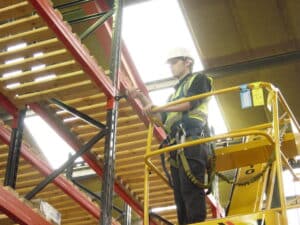Regular pallet racking maintenance is essential to ensure warehouse operations’ safety, efficiency, and longevity. Trained personnel should inspect pallet racking daily, identifying potential hazards and promptly reporting any issues.
After the installation of pallet racking, it’s crucial to remain mindful of its usage as well as the wear and tear it undergoes over time.
In accordance with Health and Safety Executive (HSE) guidelines, all pallet racks should undergo regular inspections by a registered SARI. This practice helps prevent accidents, equipment damage, and inventory loss. Compliance with HSE regulations mandates the maintenance of pallet racking systems to uphold proper health and safety conditions.

What’s included?
- Regular inspections will be conducted to identify any signs of damage, such as bent or twisted beams, loose bolts, or missing safety pins. Any damaged components will be advised and repaired or replaced promptly to prevent further deterioration and minimise the risk of collapse.
- Keeping the racking system clean is essential to prevent the accumulation of dust, debris, and other contaminants, which can compromise structural integrity and pose fire hazards. Regular cleaning ensures aisles remain clear and easy access to stored goods.
- Pallet racking maintenance checks are performed to ensure compliance with load limits. Overloading or using racks unsuitable for operation can lead to buckling or collapse. Proper stacking techniques and weight distribution must always be observed to maintain correct rack configuration.
RediRack’s Racking Maintenance
RediRack having nearly six decades in the industry are a full SEMA members, and can complete maintenance and inspections on all racking previously installed by ourselves. All inspections are thoroughly implemented by one of our in-house SARIs who will also provide a detailed report using the SEMAs traffic light reporting system.
By prioritising pallet racking maintenance, businesses can enhance workplace safety, protect valuable inventory, and optimise warehouse efficiency.



